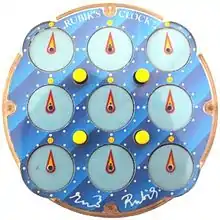Rubik's Clock
Rubik's Clock is a mechanical puzzle invented and patented by Christopher C. Wiggs and Christopher J. Taylor.[1] The Hungarian sculptor and professor of architecture Ernő Rubik bought the patent from them to market the product under his name. It was first marketed in 1988.

Rubik's Clock is a two-sided puzzle, each side presenting nine clocks to the puzzler. There are four wheels, one at each corner of the puzzle, each allowing the corresponding corner clock to be rotated directly. (The corner clocks, unlike the other clocks, rotate on both sides of the puzzle simultaneously and can never be operated independently. Thus the puzzle contains only 14 independent clocks.)
There are also four buttons which span both sides of the puzzle; each button arranged such that if it is "in" on one side it is "out" on the other. The state of each button (in or out) determines whether the adjacent corner clock is mechanically connected to the three other adjacent clocks on the front side or on the back side: thus the configuration of the buttons determines which sets of clocks can be turned simultaneously by rotating a suitable wheel.
The aim of the puzzle is to set all nine clocks to 12 o'clock (straight up) on both sides of the puzzle simultaneously. The method to do so is by starting by constructing a cross on both sides (at 12 o’clock) and then solving the corner clocks.
The Rubik’s clock is listed as one of the 17 WCA events, with records for fastest time to solve one puzzle, and the fastest average time to solve 5 puzzles (discarding the slowest and fastest times).
Solution
Solving the Rubik's clock is similar in many ways to solving a 3x3. It starts with orienting the edges and centers on one side. Then you repeat on the opposite side. After that, you solve 1 corner at a time. You do this by turning all of the clocks surrounding it until they match up, and then turn them all back to 12 o'clock. Repeat this step for all four corners, and then you are done! The clock is one of the few WCA events where you use the same solution no matter how fast you are.
Combinations
Since there are 14 independent clocks, with 12 settings each, there are a total of =1,283,918,464,548,864 possible combinations for the clock faces. This does not count for the number of pin positions.
Records
The world record for a single solve is 3.29 seconds, set by Suen Ming Chi (孫銘志) of Hong Kong on 23 March 2019 at GDSY Open 2019 in Guangzhou, China.[2]
The world record average of 5 (excluding fastest and slowest) is 3.86 seconds, set by Yunhao Lou (娄云皓) of China on 13 December 2020 at Guangzhou Good Afternoon 2020 in Guangzhou, China, with the times of (3.52), 4.28, (4.57), 3.54 and 3.76 seconds.[2]
Top 5 solvers by single solve[3]
| Name | Fastest solve | Competition |
|---|---|---|
| Suen Ming Chi (孫銘志) | 3.29s | GDSY Open 2019 |
| Dmitry Gundin | 3.34s | MPEI Open 2019 |
| Yunhao Lou (娄云皓) | 3.40s | Shenzhen Open 2018 |
| Evan Liu | 3.51s | George School Open 2019 |
| Tairan Zhong (钟泰然) | 3.64s | WCA Asian Championship 2018 |
Top 5 solvers by average of 5 solves[4]
| Name | Fastest average | Competition |
|---|---|---|
| Yunhao Lou (娄云皓) | 3.86s | Guangzhou Good Afternoon 2020 |
| Tairan Zhong (钟泰然) | 4.53s | China Championship 2019 |
| Dmitry Gundin | 4.99s | MPEI Open 2019 |
| Suen Ming Chi (孫銘志) | 5.04s | GDSY Open 2019 |
| Wojciech Knott | 5.14s | Polish Championship 2018 |
References
- Patents EP0322085 (1989-06-28), JP1171588 (1989-07-06), GB2213739 (1989-08-23), US4869506 (1989-09-26)
- World Cube Association Official Results - Rubiks Clock
- World Cube Association Official Clock Ranking Single
- World Cube Association Official Clock Ranking Average
External links
- Rubik's Clock Solution An illustrated description of the solution.
- Unofficial Records Speedsolving.com's page of unofficial records for many puzzles including Rubik's Clock
- Real Genius Computer game implementation of Rubik's Clock for the Commodore Amiga, released in 1989
